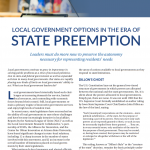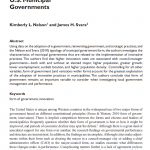Author: James Svara

Local Government Options in the Era of State Preemption
Local governments have historically faced such challenges as increasing demands for service, limited
fiscal resources, and contending with economic forces beyond their control. Still, local governments remain a primary engine of innovative government services and enjoy high levels of resident trust. In recent years, state legislatures have encroached on the ability of local governments to meet these challenges and have become increasingly intrusive in local affairs. Reports by the National League of Cities (NLC)1 as well as the Local Government Research Collaborative,2 a partnership of ICMA, the Alliance for Innovation, and the Center for Urban Innovation at Arizona State University, have found significant changes in state-local relations, including: 1) a sharp increase in the number of states
involved with this movement, and 2) an increase in the overall number of limitations placed on local governments by their state legislatures. What options do local managers and elected officials have as they try to tailor local public services to the needs and preferences of residents? This article provides an overview of this changing environment and highlights the array of actions available to local governments as they respond to state limitations.
Cite as:
Swindell, D., Svara, J. and Stenberg C.”Local Government Options in the Era of State Preemption”
…
Continued
Form of Government Still Matters: Fostering Innovation in U.S. Municipal Governments
Using data on the adoption of e-government, reinventing government, and strategic practices, and
the Nelson and Svara (2010) typology of municipal government form, the authors investigate the
characteristics of municipal governments that are related to the implementation of innovative
practices. The authors find that higher innovation rates are associated with council-manager
governments—both with and without an elected mayor, higher population, greater growth,
lower unemployment, sunbelt location, and higher population density. Controlling for all other
variables, form of government (and variations within form) account for the greatest explanation
of the adoption of innovative practices in municipalities. The authors conclude that form of
government remains an important variable to consider when investigating local government
management and performance.
Cite as:
Nelson, K.L. and Svara, James H. (2012). Form of Government Still Matters: Fostering Innovation in U.S. Municipal Governments.
…
Continued
